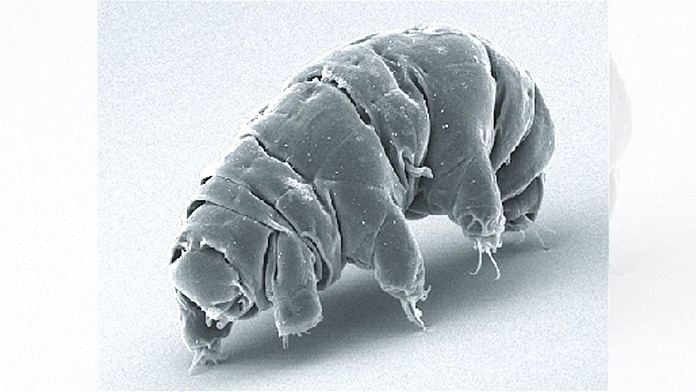Bengaluru: The next human being on the moon is likely to discover life when they get there. An eight-legged creature that recently landed on the moon.
The creature was frozen alive and sent to the moon as part of a time capsule, for possible revival when humans return there.
Meet tardigrades, water-dwelling micro-animals that resemble a croissant in appearance. They are present everywhere life has been — on top of the tallest mountain, at the bottom of the deepest sea, in the coldest regions of Antarctica, in the densest rainforests, and even inside mud volcanoes.
Now, they are also on the moon.
Earlier this year, SpaceIL, a private company from Israel, attempted to land a mission on the Moon, but their bid ended in failure when their robotic spacecraft, Beresheet (Hebrew for ‘genesis’), crashed on the satellite.
The crash destroyed almost everything on board — barring a disc of material that was to form a human library on the moon, a peek at humanity for successive species and civilisations.
According to a report published by Wired this week, it contained 30 million pages of information, human DNA samples, and thousands of tardigrades — all contained in a “roughly DVD-sized object made of thin sheets of nickel”.
This cargo of memory was sent up by a group called the Arch Mission Foundation, a non-profit that “maintains a backup of planet Earth, designed to continuously preserve and disseminate humanity’s most important knowledge across time and space”. The disc serves as the foundation’s first lunar library and, according to the Wired report, is believed to have survived the crash.
Also read: New 3D map shows Milky Way isn’t shaped like pancake but a warped wave
Hardiest creatures known
Tardigrades were chosen for the mission because they are the hardiest creatures known to humankind, considered practically indestructible and capable of surviving all kinds of extreme conditions.
The creatures, also called water bears, can live in extreme conditions but are not ‘extremophiles’, organisms that can adapt to the surroundings and exploit them for survival. Tardigrades simply bear these extreme conditions and survive despite them.
They are capable of entering a state of dehydration called cryptobiosis. They expel all water from their bodies, produce an antifreeze, and secrete a sugar that coats their bodies, equipping themselves for preservation. This state, called ‘tun’, brings down their metabolism by 99.99 per cent.
It is in this state that tardigrades are completely indestructible. Tuns have survived inside ice for several years, even getting through a trip to the vacuum of space when a 2007 European mission sent a payload of tardigrades there and exposed them to cosmic radiation.
Several survived, making them the first known forms of life to completely survive space exposure.
The Israeli lander’s tardigrade cargo was encased in protective epoxy resin that often preserves long-dead creatures in nature, and was added on to one of the disc’s 25-micron-thick layers of nickel.
Some layers contain high resolution images of books, including those with instructions for learning languages, while others have all of English-language Wikipedia. Others still have classical literature alongside American writer Isaac Asimov’s sci-fi ‘Foundation’ trilogy, samples from religious sites like India’s Bodhi tree, and hair follicles and blood samples as human DNA.
Faeces on the moon
NASA’s Planetary Protection Office disallows the contamination of other worlds by terrestrial life, including bacteria, but these rules are more stringent for bodies that could potentially hold water and be habitable, such as Mars and Saturn’s moon Enceladus.
The moon is barren to such an extent that there is no risk of contamination. In fact, Apollo astronauts who walked on the moon in the 1960s and 1970s left bags and bags of human faeces there so they could fulfil the low-weight requirements on their return journey.
The hope is that sometime in the future, humans will be able to revive the dormant tardigrades, either in a lab on the moon or by bringing them back to Earth, and see how well they coped — an analysis that is likely to yield further insights into space.
Also read: NASA telescope finds exoplanet trio that can unravel mysteries of planet formation
An earlier version of the report identified tardigrades as microscopic creatures. However, they are not, and can grow up to half a millimetre.



